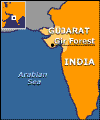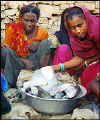| the-south-asian.com SEPTEMBER 2001 | ||
| about us contact us data bank past issues the craft shop the print gallery | ||
|
SEPTEMBER 2001 Contents Interview Heritage Cultural Heritage of south Asia People Communities Lifestyle Films Editor's Note
Books
|
Page 3 of 3
by Zachariah Cherian
Mampilly
Sidis There are identifiable Sidi communities in Gujarat, Maharashtra (around Bombay), and Hyderabad. Most of the Sidis live in Gujarat, a state in western India. Jambur, a village in the Gir forest is an exclusive Sidi settlement. The Sidis here have retained their
lineage of music and dance – their only link now with Africa. A smaller group
of Sidis lives in Junagadh, a town not far from Jambur. According to Professor
Amy Catlin, an ethno-musicologist from UCLA, who is making a special study of
Sidi culture, "In Gujarat, affinities with African music include certain
musical instruments and their names",
she says, "and also the performance of an African-derived
musical genre called "goma". their
lineage of music and dance – their only link now with Africa. A smaller group
of Sidis lives in Junagadh, a town not far from Jambur. According to Professor
Amy Catlin, an ethno-musicologist from UCLA, who is making a special study of
Sidi culture, "In Gujarat, affinities with African music include certain
musical instruments and their names",
she says, "and also the performance of an African-derived
musical genre called "goma".
Sidis also settled in Murud, once the capital of the erstwhile state of Janjira (from the Arabic ‘jazirah’ meaning an island) on the western coast of Maharashtra. The Janjira Fort at Murad was "once the stronghold of Abyssinian Sidis, who played an important role in the history of Bombay in the latter half of the 17th century". Those Sidis who settled in Janjira prospered as warriors and great sailors. Their fort still stands today in Murud – a small fishing village – as does the Sidi Palace on the outskirts of the village. Though the interior of the palace is not open to tourists, the fort can be visited. "Once the fort boasted of five hundred canons, today only a handful are left, still intact and able to tell their story. Amongst them are the three major cannons, Kalal Bangdi, Landakasam and Bhavani, the cherished weapons of the Sidis, built from five metals."- Discover India"Siddi kingdoms were established in western India in Janjira and Jaffrabad as early as 1100 AD. After their conversion to Islam, the African freedmen of India, originally called Habshi from the Arabic, called themselves Sayyad (descendants of Muhammad) and were consequently called Siddis. Indeed, the island Janjira was formerly called Habshan, meaning Habshan's or African's land. Siddi signifies lord or prince. It is further said that Siddi is an expression of respectful address commonly used in North Africa, like Sahib in India. Specifically, it is said to be an honorific title given to the descendants of African natives in the west of India, some of whom were distinguished military officers and administrators of the Muslim princes of the Deccan. … The Siddis were employed largely as security forces for Muslim fleets in the Indian Ocean, a position they maintained for centuries." - Tom Mountains Ambedkar Journal Website HABSHIS AND SIDDIS: AFRICAN DYNASTIES IN INDIA Scholars generally consider the Indo-Africans de facto Indians as they mostly speak Indian languages, although some groups do retain many African words. This process of assimilation was interrupted with the advent of British rule in India in the 19th century. The British segregated the Indo-Africans from the local population, thus impoverishing the process of assimilation. Today, except for the Royal Sidis and their descendants who are largely integrated into the Muslim upper class, the Indo-African population remains largely farmers or unskilled workers, although some have also become professionals such as doctors, lawyers, teachers and businessmen. Under the extensive Indian affirmative action programs, most Indo-Africans are classified as scheduled tribes, which entitles them to reservations in university seats and other government support.Culturally, the Indo-Africans have been accepted into the vast spectrum that is India - as have many immigrant groups ranging from the Jews who fled Israel two hundred years after Christ, to the Zoroastrians who fled Iran in the advent of Islamic imperialism. Like these groups, the Indo-Africans have full claim to being Indian, even if they maintain some of their ancestral traditions. In 1997 I met a group of American researchers who had just arrived in Dar es Salaam, Tanzania, from Karnataka in South India. It seems they had recently interviewed a rural settlement of Indo-Africans. In studying and recording the group's music, they had recognised a common melody and similar themes in the music to that which was sung by a certain ethnic group in Tanzania. Nonetheless, this group of Indo-Africans spoke only Kannada (an Indian language) and their idea of home was only India, although a few of the older members of the group knew sketchy details of tales that spoke of certain ancestors who had come from another land.Only a small number of Indo-Africans have tried to immigrate back to Africa, mostly during the British rule of Zanzibar. Those who did return have largely been assimilated into the cultural mix that characterises the island. Early in the 20th century, a woman named Langi Nur-Bai arrived in Zanzibar from India where she had been a drummer and singer. Interestingly, while in Zanzibar she became a respected member of the Indian Muslim community and was a highly demanded performer for their weddings and other such occasions.In Pakistan, which also has a small Indo-African population, Indo-Africans are substantially more visible as performers and athletes. The community, known as Makranis, is almost completely centred in the coastal city of Karachi and has achieved national status as athletes, especially as boxers, a field in which Indo-Africans have represented Pakistan in international competition.India has always welcomed immigrants from around the world, giving them acceptance and taking from them certain cultural attributes that have further enlarged the Indian mosaic. Afro-Indians, like all other groups that sought shelter in India, were given the freedom to assimilate without the pressure to lose their ancestral traditions.However one views Afro-Indians, their mere existence has much to tell us about Africa's place in the world community beyond just the dark days of slavery. Their history speaks of the African ability to integrate into a land other than that from where they originated. The African Diaspora in the Americas was an unwilling one, but the Indo-Africans came willingly to India, and regardless of their ups and downs in Indian history, they have chosen to stay there.Prominent Indo-Africans in history of India Jamal al-Din Yaqut - a royal courtier in the kingdom of Delhi who was believed to be close to the then reigning sovereign Queen Raziya (1236- 1240). He was killed by jealous rivals.Ibn Battuta recalls that at Alapur, north of Delhi, the governor was "the Abyssinian Badr..., a man whose bravery passed into a proverb".Malik Sarwar, described as a Habshi, was appointed governor of Jaunpur.Mubarak Shah, his son, later succeeded him. Ibrahim Shah, succeeded his brother Mubarak Shah, and ruled for forty years. "..the most famous among the Indo-Africans was the celebrated Malik Ambar (1550-1626). Ambar, like a number of Africans in medieval India, elevated himself to a position of great authority. Malik Ambar, whose original name was Shambu, was born around 1550 in Harar, Ethiopia. After his arrival in India, Ambar was able to raise a formidable army and achieve great power in the west Indian realm of Ahmadnagar. Ambar was a brilliant diplomat and administrator." Tom Mountains Ambedkar Journal Website HABSHIS AND SIDDIS: AFRICAN DYNASTIES IN INDIA Habshis ruled Bengal 1486-1491 by overthrowing the ruler
Jalal-al Din. _______________________________________
Copyright © 2000 - 2001 [the-south-asian.com]. Intellectual Property. All rights reserved. |
|


